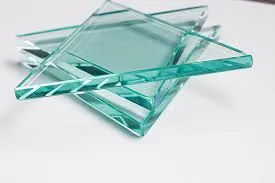The Manufacturing of Toughened Glass A Comprehensive Overview
Toughened glass, also known as tempered glass, is a type of safety glass that has been processed by controlled thermal or chemical treatments to increase its strength compared to normal glass. This innovative material plays a critical role in various applications, ranging from automotive windshields to architectural facades, due to its ability to withstand impact and thermal stress while minimizing the risk of injury in the event of breakage. The manufacturing process of toughened glass involves several key steps that ensure its durability and safety.
Step 1 Glass Selection
The first stage in the manufacturing of toughened glass involves selecting high-quality raw materials. Silica sand, soda ash, and limestone are the primary components used to create the glass. The proportions of these ingredients are meticulously calculated to produce glass with the desired properties, ensuring clarity and strength. Other additives may also be included to enhance specific characteristics, such as UV resistance or color.
Step 2 Melting and Forming
Once the raw materials are prepared, they are mixed and heated in a furnace at temperatures reaching around 1600 degrees Celsius. This process melts the ingredients into a molten glass. After reaching a uniform consistency, the molten glass can be formed into sheets of various thicknesses using different techniques, including float glass production, where the glass is floated on molten tin to create a smooth surface.
Step 3 Annealing
manufacturing of toughened glass
Post-formation, the raw glass undergoes an annealing process, which is essential for relieving internal stresses. This step involves slowly cooling the glass in a controlled environment to ensure that it maintains uniform thickness and clarity. Proper annealing is crucial, as it sets the stage for successful toughening.
Step 4 Toughening
The toughening process is where the transformation into toughened glass occurs. The annealed glass sheets are subjected to a rapid heating and cooling cycle. Initially, the glass is heated to approximately 620 degrees Celsius and then quickly cooled using powerful jets of cold air. This process creates compressive stresses on the surface of the glass while inducing tensile stresses within, resulting in a material that is significantly stronger than its non-tempered counterparts. In fact, toughened glass can be up to five times stronger than untempered glass of the same thickness.
Step 5 Cutting and Finishing
After the toughening process, the glass can be cut to size and further processed as needed. This may involve edge finishing, surface coating, or drilling holes, depending on the intended application. It is essential to note that once glass has been toughened, it cannot be cut or altered without risking the integrity of the material.
Conclusion
The manufacturing of toughened glass is a complex process that combines science and technology to create a material that meets the demands of modern safety standards. Its remarkable strength and safety characteristics make it an invaluable resource across various industries, ensuring the protection of individuals and enhancing the aesthetic appeal of structures. As technology advances, further improvements in the manufacturing process of toughened glass are anticipated, paving the way for even broader applications in the future.
 Afrikaans
Afrikaans  Albanian
Albanian  Amharic
Amharic  Arabic
Arabic  Armenian
Armenian  Azerbaijani
Azerbaijani  Basque
Basque  Belarusian
Belarusian  Bengali
Bengali  Bosnian
Bosnian  Bulgarian
Bulgarian  Catalan
Catalan  Cebuano
Cebuano  Corsican
Corsican  Croatian
Croatian  Czech
Czech  Danish
Danish  Dutch
Dutch  English
English  Esperanto
Esperanto  Estonian
Estonian  Finnish
Finnish  French
French  Frisian
Frisian  Galician
Galician  Georgian
Georgian  German
German  Greek
Greek  Gujarati
Gujarati  Haitian Creole
Haitian Creole  hausa
hausa  hawaiian
hawaiian  Hebrew
Hebrew  Hindi
Hindi  Miao
Miao  Hungarian
Hungarian  Icelandic
Icelandic  igbo
igbo  Indonesian
Indonesian  irish
irish  Italian
Italian  Japanese
Japanese  Javanese
Javanese  Kannada
Kannada  kazakh
kazakh  Khmer
Khmer  Rwandese
Rwandese  Korean
Korean  Kurdish
Kurdish  Kyrgyz
Kyrgyz  Lao
Lao  Latin
Latin  Latvian
Latvian  Lithuanian
Lithuanian  Luxembourgish
Luxembourgish  Macedonian
Macedonian  Malgashi
Malgashi  Malay
Malay  Malayalam
Malayalam  Maltese
Maltese  Maori
Maori  Marathi
Marathi  Mongolian
Mongolian  Myanmar
Myanmar  Nepali
Nepali  Norwegian
Norwegian  Norwegian
Norwegian  Occitan
Occitan  Pashto
Pashto  Persian
Persian  Polish
Polish  Portuguese
Portuguese  Punjabi
Punjabi  Romanian
Romanian  Russian
Russian  Samoan
Samoan  Scottish Gaelic
Scottish Gaelic  Serbian
Serbian  Sesotho
Sesotho  Shona
Shona  Sindhi
Sindhi  Sinhala
Sinhala  Slovak
Slovak  Slovenian
Slovenian  Somali
Somali  Spanish
Spanish  Sundanese
Sundanese  Swahili
Swahili  Swedish
Swedish  Tagalog
Tagalog  Tajik
Tajik  Tamil
Tamil  Tatar
Tatar  Telugu
Telugu  Thai
Thai  Turkish
Turkish  Turkmen
Turkmen  Ukrainian
Ukrainian  Urdu
Urdu  Uighur
Uighur  Uzbek
Uzbek  Vietnamese
Vietnamese  Welsh
Welsh  Bantu
Bantu  Yiddish
Yiddish  Yoruba
Yoruba  Zulu
Zulu 

